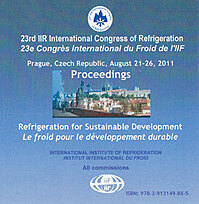
Summary
The flow boiling heat transfer of CO2-oil-mixtures inside a round tube was experimentally investigated. The experimental results and a comparison to established correlations from literature are presented. Since oil is used for the lubrication of the compressors in refrigeration cycles, it becomes a circulating fluid influencing the flow boiling heat transfer. Reports concerning the effort on describing the oil effect on the heat transfer reveal that a general statement about the influence of the oil cannot be made as different types of oil (also in dependency of the refrigerant) can show different behaviour in density, viscosity, specific heat, surface tension and miscibility. These (mixture-) properties affect the tube-wetting characteristic and foam formation inside the tube (and generally the flow pattern) and the heat transfer of the boiling fluid. Concentrations of 1% in weight can show a significant change in heat transfer already (Hambraeus (1995), Thome (1996), Kedzierski (2007) and Bandarra Filho et al. (2009)). The Experiments were carried out at the flow boiling test facility of the Institute of Thermal Process Engineering at the KIT, in Karlsruhe/Germany. The test loop consists of a brine-cooled condenser, 4 preheaters in line, a test section with subsequent guard heater and a sight glass. Additionally, an oil loop with super-heater and oil separator allows the addition or removing of lubricant oil to the test loop. As test section, a smooth tube of 14 mm inner diameter and a cuprofin tube of 8.6 mm were available. Six segmented electrically heated sections around the circumference of the tubes and sophisticated temperature measurements allow the determination of local heat transfer coefficients at isothermal conditions. Flow patterns were observed through the sight glass (same inner tube diameter as test section) at adiabatic conditions using high speed video recording at 500/ 1000 fps. Experimental results for CO2 flow boiling heat transfer inside the smooth tube are in good agreement with the correlation by Steiner (2006). However, experimental results of the heat transfer for CO2-oil-mixtures partly show a great deviation especially in the convective boiling region (low heat fluxes) and for high heat fluxes near the critical heat flux. Whereas the heat transfer coefficient in the convective boiling region shows a general decrease, it was also observed that the heat transfer coefficient for medium void fractions (0.5 < x < 0.7) increased with respect to pure CO2.
Available documents
Format PDF
Pages: 8 p.
Available
Public price
20 €
Member price*
Free
* Best rate depending on membership category (see the detailed benefits of individual and corporate memberships).
Details
- Original title: Investigations on the flow boiling heat transfer of CO2 and CO2-oil-mixtures.
- Record ID : 30002018
- Languages: English
- Source: Proceedings of the 23rd IIR International Congress of Refrigeration: Prague, Czech Republic, August 21-26, 2011. Overarching theme: Refrigeration for Sustainable Development.
- Publication date: 2011/08/21
Links
See other articles from the proceedings (569)
See the conference proceedings
Indexing
-
Measurement of flow boiling heat transfer coeff...
- Author(s) : GAO L., HAMADA W., HONDA T.
- Date : 2011/08/21
- Languages : English
- Source: Proceedings of the 23rd IIR International Congress of Refrigeration: Prague, Czech Republic, August 21-26, 2011. Overarching theme: Refrigeration for Sustainable Development.
- Formats : PDF
View record
-
Experiments on flow boiling characteristics of ...
- Author(s) : JIGE D., KIKUCHI S., EDA H., et al.
- Date : 2019/08/24
- Languages : English
- Source: Proceedings of the 25th IIR International Congress of Refrigeration: Montréal , Canada, August 24-30, 2019.
- Formats : PDF
View record
-
Flow boiling heat transfer characteristics of C...
- Author(s) : GAO L., WATANABE Y., SATO M., et al.
- Date : 2010/06/07
- Languages : English
- Source: ACRA2010. Asian conference on refrigeration and air conditioning: Tokyo, Japan, June 7-9, 2010.
- Formats : PDF
View record
-
R744 flow boiling heat transfer with and withou...
- Author(s) : KIM S., PEHLIVANOGLU N., HRNJAK P.
- Date : 2010/07/12
- Languages : English
- Source: 2010 Purdue Conferences. 13th International Refrigeration and Air-Conditioning Conference at Purdue.
- Formats : PDF
View record
-
Flow boiling heat transfer performance of R448A...
- Author(s) : HIEU H. N., AGUSTIARINI N., OH J. T., KIM J. K.
- Date : 2023/05/15
- Languages : English
- Source: 14th IEA Heat Pump Conference 2023, Chicago, Illinois.
- Formats : PDF
View record
